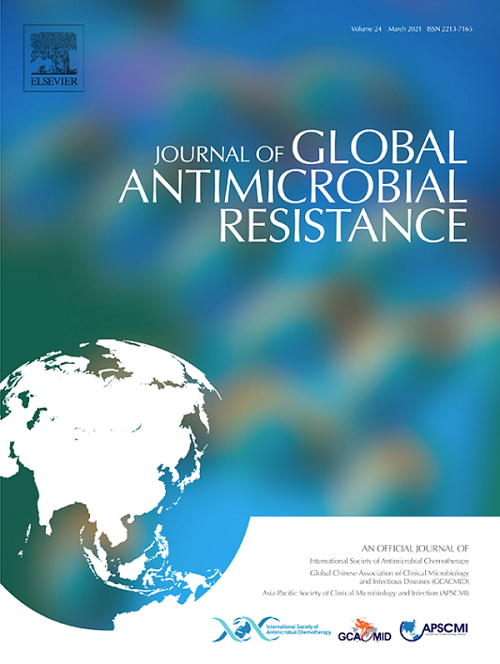is26介导的协整在肺炎克雷伯菌中产生了blaIMP-4和blaKPC-2共存的质粒。
IF 3.7
3区 医学
Q2 INFECTIOUS DISEASES
引用次数: 0
摘要
背景:本研究旨在探讨碳青霉烯耐药肺炎克雷伯菌中blaIMP-4和blaKPC-2共载质粒的表型和基因型特征。方法:从60岁患者身上分离K194菌株。采用MALDI-TOF质谱法进行菌种鉴定,并进行药敏试验。检测耐药基因,用Southern blot法鉴定质粒的S1-PFGE。使用Illumina和Oxford Nanopore平台进行全基因组测序。结果:肺炎克雷伯菌K194对碳青霉烯类等多种抗生素耐药。该菌株在一个163kb的质粒(pK194-P2)上同时携带blaIMP-4和blaKPC-2。pK194-P2体外偶联效率为3.4 × 10-7。全基因组分析证实pK194-P2是一种新型质粒,具有IncFII型和incn型复制子。序列比对显示,在以两个IS26拷贝为界的109 kb区域两侧有直接重复序列(GCCCAAGG)。体外进化实验表明,pK194-P2中的blaKPC-2在转缀合物中传代10天后可以稳定维持,而blaIMP-4在实验室重复传代过程中可能丢失。对两个blaimp -4阴性质粒与pK194-P2的全基因组测序和比对显示,它们在IS26附近缺失了81 kb或94 kb。结论:本研究报道了肺炎克雷伯菌中blaIMP-4和blaKPC-2共存的一种新型质粒,并强调了is26介导的协整和缺失在质粒形成和进化中的潜在作用。本文章由计算机程序翻译,如有差异,请以英文原文为准。
IS26-mediated cointegration generates a plasmid co-harbouring blaIMP-4 and blaKPC-2 in Klebsiella pneumoniae
Background
This study aims to explore the phenotypic and genotypic characteristics of a plasmid that co-harbours blaIMP-4 and blaKPC-2 in a carbapenem-resistant Klebsiella pneumoniae.
Methods
Strain K194 was isolated from a 60-year-old patient. Species identification was performed with matrix-assisted laser desorption/ionization time-of-flight mass spectrometry, followed by antibiotic susceptibility testing. Antimicrobial resistance genes were detected and S1-pulsed-field gel electrophoresis with Southern blot experiments were performed to identify plasmids. Whole-genome sequencing was executed with the Illumina and Oxford Nanopore platforms.
Results
K. pneumoniae K194 was resistant to multiple antibiotics, including carbapenems. This strain carried both blaIMP-4 and blaKPC-2 on a single 163 kb plasmid (pK194-P2). pK194-P2 was capable of conjugation with an efficiency of 3.4 × 10–7 in vitro conjugation experiments. Whole-genome analysis confirmed that pK194-P2 was a novel plasmid and had both IncFII- and IncN-type replicons. Sequence alignment revealed direct repeats of the sequences (GCCCAAGG) flanking a 109-kb region bounded by two copies of IS26. In vitro, evolution experiments showed that blaKPC-2 in pK194-P2 could be stably maintained in the transconjugants after 10 days of passage, while blaIMP-4 could be lost during repeated laboratory passage. Whole-genome sequencing and alignment of two blaIMP-4-negative plasmids with pK194-P2 revealed that they had a deletion of 81 or 94 kb adjacent to IS26.
Conclusions
Our study reports a novel plasmid co-harbouring blaIMP-4 and blaKPC-2 in K. pneumoniae, and highlights the potential role of IS26-mediated cointegration and deletion in plasmid formation and evolution.
求助全文
通过发布文献求助,成功后即可免费获取论文全文。
去求助
来源期刊

Journal of global antimicrobial resistance
INFECTIOUS DISEASES-PHARMACOLOGY & PHARMACY
CiteScore
8.70
自引率
2.20%
发文量
285
审稿时长
34 weeks
期刊介绍:
The Journal of Global Antimicrobial Resistance (JGAR) is a quarterly online journal run by an international Editorial Board that focuses on the global spread of antibiotic-resistant microbes.
JGAR is a dedicated journal for all professionals working in research, health care, the environment and animal infection control, aiming to track the resistance threat worldwide and provides a single voice devoted to antimicrobial resistance (AMR).
Featuring peer-reviewed and up to date research articles, reviews, short notes and hot topics JGAR covers the key topics related to antibacterial, antiviral, antifungal and antiparasitic resistance.
 求助内容:
求助内容: 应助结果提醒方式:
应助结果提醒方式:


